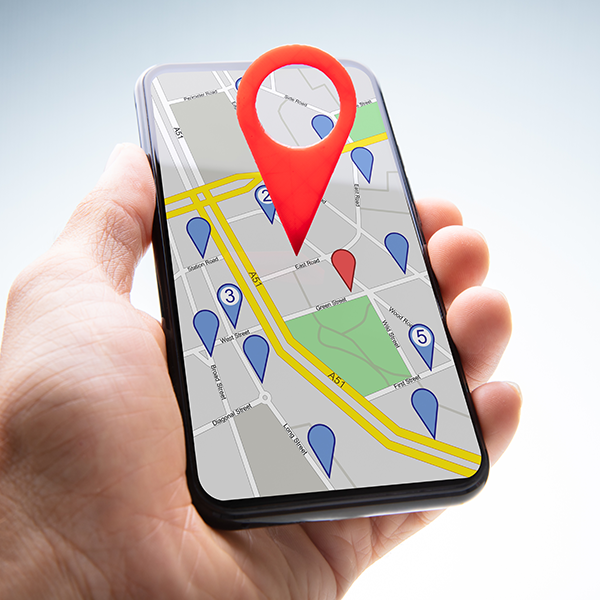5 Mobile Website Issues Marketers Need to Watch

Despite the effort and investment that has been made in improving mobile websites, they are still falling far short of visitor expectations. According to internal research, the top issue for people is still speed, as 96 percent of people said they encountered sites that are too slow. Due to speed as well as other issues, 91 percent have said that they have used a competitor's website instead.
With these expectations in mind, marketers are under real pressure to deliver. In this article, we look at five key marketing considerations when developing for mobile:
1. How can I tell if my site is fast enough?
People are impatient with slow websites and this costs brands heavily. At a recent conference, a spokesman for Walmart commented that for every second that a page takes to load, conversion halves. This creates an immediate need for marketers to be able to align bandwidth speed with conversion. As a visitor's bandwidth decreases and page load time increases, bounce rates also increase. How much of a problem this is for your site will be determined by the proportion of traffic you have coming from devices that are connecting with slower bandwidth compared to faster bandwidth.
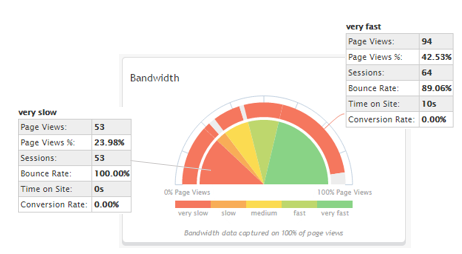
An example of mobile analytics showing bandwidth speeds.
2. How can I tell if I have the right content on my site?
By using contextual data, it is possible to instantly detect whether the content that you have on your site matches the expectations of visitors. For instance, people visiting in the mornings with smartphones are likely to be far more distracted than tablet users in the evening, right? Knowing more about the engagement of your visitors according to the time of day is vital for making the right choices about content. It also helps to set the right expectations about how content will perform. A higher bounce rate in the morning indicates that content might not be hitting the right note with your morning visitors compared to your evening visitors. For example, is video effective for engagement in the morning or is evening the optimum time for rich content?
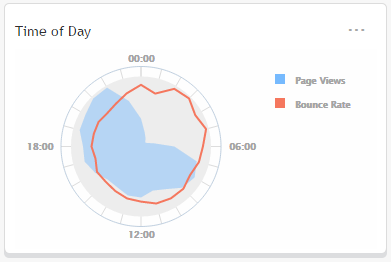
Bounce rate and conversion against time of day.
3. How can I segment customers and analyse data without employing a big data specialist?
The key to success with big data is being able to link it back to the people that create the data points. Every data point is created by an individual user who is revealing something about their behavior or preferences. Customers choose the time that they visit your site, they choose the device that they use and the location that they are using it from. There are certain characteristics that bundle these dynamic data points into groups, or segments, of customers. After segmenting, targeted experiences become much easier. However, the barrier to segmenting is the sheer amount of data involved. Marketers should be looking at analytics solutions that can provide out-of-the-box data points, or what some have called personas. These ready-made segments chart user characteristics and multiple data points to neatly bring together information without the assistance of data scientists.
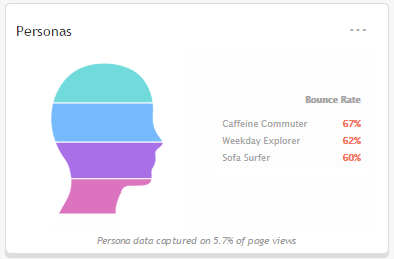
User Personas that simplify segmentation for bounce rate and other elements.
In this example, we can see that the caffeine commuter group (a category of people who engage with mobile while 'on the go' in the morning), has a much higher bounce than sofa surfers (the visitors who are at home in the evening on tablets). So while this site is catering for the rich experience needed for tablet surfing, people who are commuting are not as engaged. Sound simple? Yes, it is really.
4. How can I improve conversion?
Ideally, customers should convert in the same way, regardless of the size of the device they are using or the software they choose. Here, analytics can help identify problems with sites and shows instantly how much these problems are costing you. Here's a quick example:
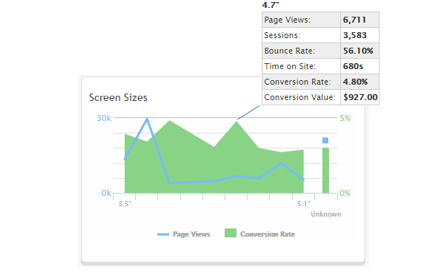
Conversion rate mapped with screen size and page views.
In this chart, we can see that 4.7" screens are hitting a much better conversion rate than the site average. It could mean that something is not working for visitors on smaller screens. Maybe the action item is too far down the screen. Maybe it is not visible? Alternatively, it enables marketers to ask what is working on the 4.7" that is failing on other screen sizes. It may not just be screen size - maybe Android visitors are not converting as well as Apple visitors. Internal research shows that users of iOS devices had different spending habits compared to Android users, with iOS users inclined to spend more overall. So, if your site has a better conversion rate for iOS users than Android, does this suggest that the price points of featured products are not hitting the spot for the Android audience? Don't forget, it could be also a technical issue. If there is a big discrepancy with a particular browser or operating system, a technical issue is the likely culprit. Analytics should instantly show you where there is a problem and how much in conversion this is costing.
5. What traffic patterns and trends do I need to look out for?
One of the great things about instantly available data is that it can reveal straight away how changes affect traffic and campaign results. One potential example is a client evaluating PPC campaigns which were driving high Web traffic, but also high bounce. The client canceled one keyword in the PPC campaign in order to test the impact. It was one which they were bidding on, and spending almost 40 percent of their campaign budget due to the high-click through rate. Within the same day, after canceling the one word, their smartphone (specifically Android smartphone) traffic dropped 70 percent. That looked bad. But we also saw that bounce rates dropped 25 percent, which meant they were now paying for the right kind of visitors who were spending more time on site. Further optimization of campaign spend was carried out with a more targeted audience, this was then tested in real-time.
Summary
Defining the questions that you want to answer from the data that is being created by your mobile Web visitors is key to success. Mobile Web analytics is not about creating an interesting graph about how many users on your site own an Apple or Samsung device. It is about establishing conclusions from big sets of data; it's about learning and then applying that learning in order to optimize return on investment for marketing projects and campaigns. The questions can be difficult to determine when there is no data to see - a chicken and an egg problem. It's a fun journey of discovery - even more so because the insights into visitor behavior are always full of surprises. But it's mainly about arming oneself with the right information to ensure investment in mobile strategy delivers the results that are needed.

Subscribe to Our Newsletter!
Latest in Marketing







